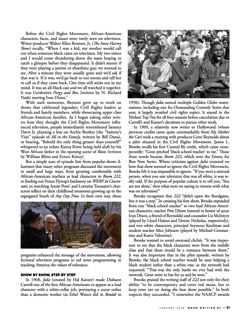America’s Never-ending Conversation About Race: Telecasting The Civil Rights Movement by Rosanne Welch
Written By Magazine, January 2018
I have an article about how the Civil Rights Movement was reflected on the TV shows of the 1960s and 70s – “America’s Neverending Conversation” in the current issue (January 2018) of Written By which is out today with revolving covers (like TV Guide does with special issues) featuring Lena Waite and/or Jordan Peele.
I had the wonderful experience of interviewing Jim Brooks about Room 222, a show I watched incessantly in my childhood before I knew what an ‘ideology’ was and that I was being offered one – and I spoke at length with Nancy Miller at length about Any Day Now – a show that relished highlighting the brave men and women who worked in the Civil Rights Movement – and still do.
You can read the whole issue digitally at this link.
By 1968, the Civil Rights Movement had celebrated many accomplishments, among them the Brown v. Board of Education of Topeka, Kansas ruling in 1954, the Montgomery Bus Boycott of 1955-1956, the Civil Rights Act of 1964, and the Voting Rights Act of 1965. Those milestones were discussed often on the evening news then and are common topics in history classrooms today.
Less common was mention of the movement or evidence of its existence on fictional television shows. While big movies such as Guess Who’s Coming to Dinner? (1967, written by William Rose) appeared at the height of the movement, in many cases they were preaching to the choir since audiences had to choose to pay to see the films.
That left the small screen to bring the conversation about civil rights into American living rooms—in places where the message might not be wanted…often without warning. This made the exposure to the message that much more potent. Viewers could be confronted with issues they’d otherwise avoided in their daily lives. Unlike today, with social media’s virulent “fake news” and insular websites bolstering extremist interpretations, there was no sane way to deny documented reality other than turning off the set—then, as now, a difficult choice for most people.



